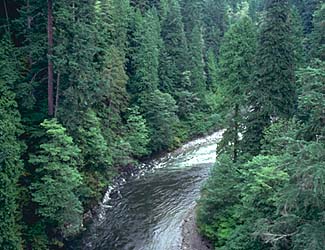
Home | About Us | Maps | Animal Facts
GAP Analysis Predicted Distribution Map

Home | About Us | Maps | Animal Facts
Bald Eagle (Haliaeetus leucocephalus)Species Code: HALE
|
Habitat
This species is common along salt and freshwater bodies at lower elevations throughout western Washington. They are especially common along the Puget Sound, throughout the San Juan Islands, and along the Olympic Peninsula coastline. They are also found along many major rivers in western Washington. They are uncommon along major river valleys and lakes in eastern Washington, mostly along the Okanogan, Sanpoil, Kettle, Columbia, Colville, and Pend Oreille Rivers. They are not found breeding in the Methow valley, apparently this is due to a lack of suitable nesting habitat.
In western Washington, all zones below Silver Fir were core areas of use. Water, wetlands, and shoreline habitats were good, but since this species also uses adjacent habitat, all other habitats along major rivers and shorelines (except mid to high-density development) were also good. Peripheral areas of use included scattered locations in parts of the steppe, Ponderosa Pine, Oak, and Interior Douglas-fir zones in eastern Washington, where water and wetlands were good habitats.

In the San Juan Islands, there is a tremendous concentration of Bald Eagles. Other areas with dense nesting populations include the coast between Port Angeles and Copalis Beach and along islands in Whatcom, Skagit, and Island Counties. This species also commonly nests along major rivers in western Washington. Bald Eagles are not adverse to nesting near people, as several nests within the Seattle city limits demonstrate. Two published surveys have shown a marked increase of Bald Eagle nesting Washington in recent years. In eastern Washington, Bald Eagle nests are much less common, but known from the rivers named above. Nests along the Hanford Reach are in an unusual habitat and may have diminished success, as evidenced by one in which a clutch was laid but no young fledged. Along the eastern Cascade slope, Bald Eagles are uncommon breeders at large lakes and reservoirs with suitable prey. Despite their reported preference for fish, a dietary study of Bald Eagles on the San Juan Islands noted that rabbits were the main food item though always as carrion.
Translated from the Washington Gap Analysis Bird Volume by Uchenna Bright
Text edited by Gussie Litwer
Map by Dave Lester